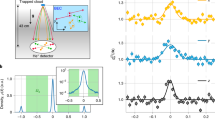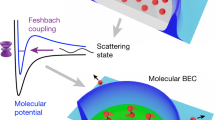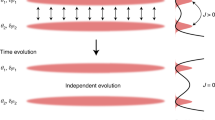Abstract
Strongly correlated quantum matter, such as interacting electron systems or interacting quantum fluids, exhibits properties that defy explanation in terms of linear fluctuations and free quasiparticles. In these systems, quantum fluctuations are large and generically display non-Gaussian statistics—a property captured only by inspecting high-order correlations, whose quantitative reconstruction presents a challenge for both experiments and theory. A prime example of correlated quantum matter is the strongly interacting Bose fluid, realized first in superfluid helium and, more recently, in ultracold atoms. Here, we experimentally study interacting Bose gases from the weakly to the strongly interacting regime through single-atom-resolved correlations in momentum space. We find that the Bogoliubov pairing among modes of opposite momenta, characteristic of the weakly interacting regime, is suppressed as interactions grow. This departure from the predictions of Bogoliubov theory marks the onset of the strongly correlated regime, as confirmed by numerical simulations that highlight the role of nonlinear quantum fluctuations in our system. Furthermore, our measurements reveal a non-zero four-operator cumulant at even stronger interactions, which is a direct signature of non-Gaussian correlations. These results shed light on the emergence and physical origin of non-Gaussian correlations in ensembles of interacting bosons.
This is a preview of subscription content, access via your institution
Access options
Access Nature and 54 other Nature Portfolio journals
Get Nature+, our best-value online-access subscription
$32.99 / 30 days
cancel any time
Subscribe to this journal
Receive 12 print issues and online access
$259.00 per year
only $21.58 per issue
Buy this article
- Purchase on SpringerLink
- Instant access to full article PDF
Prices may be subject to local taxes which are calculated during checkout



Similar content being viewed by others
Data availability
All data shown in this paper are available from the corresponding author upon reasonable request. Source data are provided with this paper.
References
Sachdev, S. Quantum Phases of Matter (Cambridge Univ. Press, 2023).
Paschen, S. & Si, Q. Quantum phases driven by strong correlations. Nat. Rev. Phys. 3, 9–26 (2021).
Polkovnikov, A., Sengupta, K., Silva, A. & Vengalattore, M. Colloquium: nonequilibrium dynamics of closed interacting quantum systems. Rev. Mod. Phys. 83, 863–883 (2011).
Wang, X.-B., Hiroshima, T., Tomita, A. & Hayashi, M. Quantum information with Gaussian states. Phys. Rep. 448, 1–111 (2007).
Morosan, E., Natelson, D., Nevidomskyy, A. H. & Si, Q. Strongly correlated materials. Adv. Mater. 24, 4896–4923 (2012).
Adams, A., Carr, L. D., Schäfer, T., Steinberg, P. & Thomas, J. E. Strongly correlated quantum fluids: ultracold quantum gases, quantum chromodynamic plasmas and holographic duality. New J. Phys. 14, 115009 (2012).
Bloch, J., Cavalleri, A., Galitski, V., Hafezi, M. & Rubio, A. Strongly correlated electron–photon systems. Nature 606, 41–48 (2022).
Chevy, F. & Salomon, C. Strongly correlated Bose gases. J. Phys. B: Atom. Mol. Opt. Phys. 49, 192001 (2016).
Georges, A., Kotliar, G., Krauth, W. & Rozenberg, M. J. Dynamical mean-field theory of strongly correlated fermion systems and the limit of infinite dimensions. Rev. Mod. Phys. 68, 13–125 (1996).
Metzner, W., Salmhofer, M., Honerkamp, C., Meden, V. & Schönhammer, K. Functional renormalization group approach to correlated fermion systems. Rev. Mod. Phys. 84, 299–352 (2012).
Georges, A., Medici, L.D. & Mravlje, J. Strong correlations from Hund’s coupling. Annu. Rev. Condens. Matter Phys. 4, 137–178 (2013).
Chang, D. E., Vuletić, V. & Lukin, M. D. Quantum nonlinear optics—photon by photon. Nat. Photon. 8, 685–694 (2014).
Armijo, J., Jacqmin, T., Kheruntsyan, K. V. & Bouchoule, I. Probing three-body correlations in a quantum gas using the measurement of the third moment of density fluctuations. Phys. Rev. Lett. 105, 230402 (2010).
Schweigler, T. et al. Experimental characterization of a quantum many-body system via higher-order correlations. Nature 545, 323–326 (2017).
Rispoli, M. et al. Quantum critical behaviour at the many-body localization transition. Nature 573, 385–389 (2019).
Bogoliubov, N. On the theory of superfluidity. J. Phys. (USSR) 11, 23 (1947).
Lee, T. D., Huang, K. & Yang, C. N. Eigenvalues and eigenfunctions of a Bose system of hard spheres and its low-temperature properties. Phys. Rev. 106, 1135–1145 (1957).
Navon, N. et al. Dynamics and thermodynamics of the low-temperature strongly interacting bose gas. Phys. Rev. Lett. 107, 135301 (2011).
Jørgensen, N. B., Bruun, G. M. & Arlt, J. J. Dilute fluid governed by quantum fluctuations. Phys. Rev. Lett. 121, 173403 (2018).
Pitaevskii, L. & Stringari, S. Uncertainty principle, quantum fluctuations and broken symmetries. J. Low Temp. Phys. 85, 377–388 (1991).
Lopes, R. et al. Quantum depletion of a homogeneous Bose–Einstein condensate. Phys. Rev. Lett. 119, 190404 (2017).
Tenart, A., Hercé, G., Bureik, J.-P., Dareau, A. & Clément, D. Observation of pairs of atoms at opposite momenta in an equilibrium interacting Bose gas. Nat. Phys. 17, 1364–1368 (2021).
Ceperley, D. M. Path integrals in the theory of condensed helium. Rev. Mod. Phys. 67, 279–355 (1995).
Svistunov, B. V., Babaev, E. S. & Prokof’ev, N. V. Superfluid States of Matter (CRC Press, 2015).
Fisher, M. P. A., Weichman, P. B., Grinstein, G. & Fisher, D. S. Boson localization and the superfluid-insulator transition. Phys. Rev. B 40, 546–570 (1989).
Bloch, I., Dalibard, J. & Zwerger, W. Many-body physics with ultracold gases. Rev. Mod. Phys. 80, 885–964 (2008).
Georgescu, I. M., Ashhab, S. & Nori, F. Quantum simulation. Rev. Mod. Phys. 86, 153–185 (2014).
Makotyn, P., Klauss, C. E., Goldberger, D. L., Cornell, E. A. & Jin, D. S. Universal dynamics of a degenerate unitary Bose gas. Nat. Phys. 10, 116–119 (2014).
Fletcher, R. J. et al. Two- and three-body contacts in the unitary Bose gas. Science 355, 377–380 (2017).
Eismann, U. et al. Universal loss dynamics in a unitary Bose gas. Phys. Rev. X 6, 021025 (2016).
Klauss, C. E. et al. Observation of efimov molecules created from a resonantly interacting Bose gas. Phys. Rev. Lett. 119, 143401 (2017).
Eigen, C. et al. Universal prethermal dynamics of Bose gases quenched to unitarity. Nature 563, 221–224 (2018).
Yan, Z. Z., Ni, Y., Robens, C. & Zwierlein, M. W. Bose polarons near quantum criticality. Science 368, 190–194 (2020).
Schellekens, M. et al. Hanbury Brown Twiss effect for ultracold quantum gases. Science 310, 648–651 (2005).
Vassen, W. et al. Cold and trapped metastable noble gases. Rev. Mod. Phys. 84, 175–210 (2012).
Cayla, H. et al. Single-atom-resolved probing of lattice gases in momentum space. Phys. Rev. A 97, 061609 (2018).
Dall, R. G. et al. Ideal n-body correlations with massive particles. Nat. Phys. 9, 341–344 (2013).
Hercé, G. et al. Full counting statistics of interacting lattice gases after an expansion: the role of condensate depletion in many-body coherence. Phys. Rev. Res. 5, L012037 (2023).
Fetter, A. L. & Walecka, J. D. Quantum Theory of Many-Particle Systems (Dover, 2012).
Carlen, E. A., Holzmann, M., Jauslin, I. & Lieb, E. H. Simplified approach to the repulsive Bose gas from low to high densities and its numerical accuracy. Phys. Rev. A 103, 053309 (2021).
Ursell, H. D. The evaluation of Gibbs’ phase-integral for imperfect gases. Math. Proc. Camb. Philos. Soc. 23, 685–697 (1927).
Bouton, Q. et al. Fast production of Bose–Einstein condensates of metastable helium. Phys. Rev. A 91, 061402 (2015).
Carcy, C., Hercé, G., Tenart, A., Roscilde, T. & Clément, D. Certifying the adiabatic preparation of ultracold lattice bosons in the vicinity of the Mott transition. Phys. Rev. Lett. 126, 045301 (2021).
Nogrette, F. et al. Characterization of a detector chain using a FPGA-based time-to-digital converter to reconstruct the three-dimensional coordinates of single particles at high flux. Rev. Sci. Instrum. 86, 113105 (2015).
Tenart, A. et al. Two-body collisions in the time-of-flight dynamics of lattice Bose superfluids. Phys. Rev. Res. 2, 013017 (2020).
Hercé, G. et al. Studying the low-entropy mott transition of bosons in a three-dimensional optical lattice by measuring the full momentum-space density. Phys. Rev. A 104, L011301 (2021).
Toth, E., Rey, A. M. & Blakie, P. B. Theory of correlations between ultracold bosons released from an optical lattice. Phys. Rev. A 78, 013627 (2008).
Cayla, H. et al. Hanbury Brown and Twiss bunching of phonons and of the quantum depletion in an interacting Bose gas. Phys. Rev. Lett. 125, 165301 (2020).
Wallin, M., So/rensen, E. S., Girvin, S. M. & Young, A. P. Superconductor–insulator transition in two-dimensional dirty boson systems. Phys. Rev. B 49, 12115–12139 (1994).
Roscilde, T. Bosons in one-dimensional incommensurate superlattices. Phys. Rev. A 77, 063605 (2008).
Fang, B., Johnson, A., Roscilde, T. & Bouchoule, I. Momentum-space correlations of a one-dimensional Bose gas. Phys. Rev. Lett. 116, 050402 (2016).
Ferioli, G. et al. Non-Gaussian correlations in the steady state of driven-dissipative clouds of two-level atoms. Phys. Rev. Lett. 132, 133601 (2024).
Rom, T. et al. Free fermion antibunching in a degenerate atomic Fermi gas released from an optical lattice. Nature 444, 733–736 (2006).
Acknowledgements
We thank E. Gradova for her contribution to the bootstrap analysis, T. Chalopin for a careful reading of the paper and D. Boiron and the members of the Quantum Gas group at Institut d’Optique for insightful discussions. We acknowledge financial support from the Région Ile-de-France in the framework of the DIM SIRTEQ, the ‘Fondation d’entreprise iXcore pour la Recherche’, the French National Research Agency (grant no. ANR-17-CE30-0020-01) and France 2030 programmes of the French National Research Agency (grant nos. ANR-22-PETQ-0004 and ANR-11-IDEX-0003). All numerical simulations were made on the PSMN cluster at the ENS of Lyon.
Author information
Authors and Affiliations
Contributions
J.-P.B., G.H. and A.T. carried out the experiments. T.R. conducted the theoretical simulations. All of the authors contributed to the data analysis, progression of the project and writing of the paper.
Corresponding author
Ethics declarations
Competing interests
The authors declare no competing interests.
Peer review
Peer review information
Nature Physics thanks the anonymous reviewers for their contribution to the peer review of this work.
Additional information
Publisher’s note Springer Nature remains neutral with regard to jurisdictional claims in published maps and institutional affiliations.
Supplementary information
Supplementary Information
Supplementary Figs. 1–8 and Discussion.
Source data
Source Data Fig. 2
Statistical source data.
Source Data Fig. 3
Statistical source data.
Rights and permissions
Springer Nature or its licensor (e.g. a society or other partner) holds exclusive rights to this article under a publishing agreement with the author(s) or other rightsholder(s); author self-archiving of the accepted manuscript version of this article is solely governed by the terms of such publishing agreement and applicable law.
About this article
Cite this article
Bureik, JP., Hercé, G., Allemand, M. et al. Suppression of Bogoliubov momentum pairing and emergence of non-Gaussian correlations in ultracold interacting Bose gases. Nat. Phys. 21, 57–62 (2025). https://doi.org/10.1038/s41567-024-02700-z
Received:
Accepted:
Published:
Issue date:
DOI: https://doi.org/10.1038/s41567-024-02700-z



